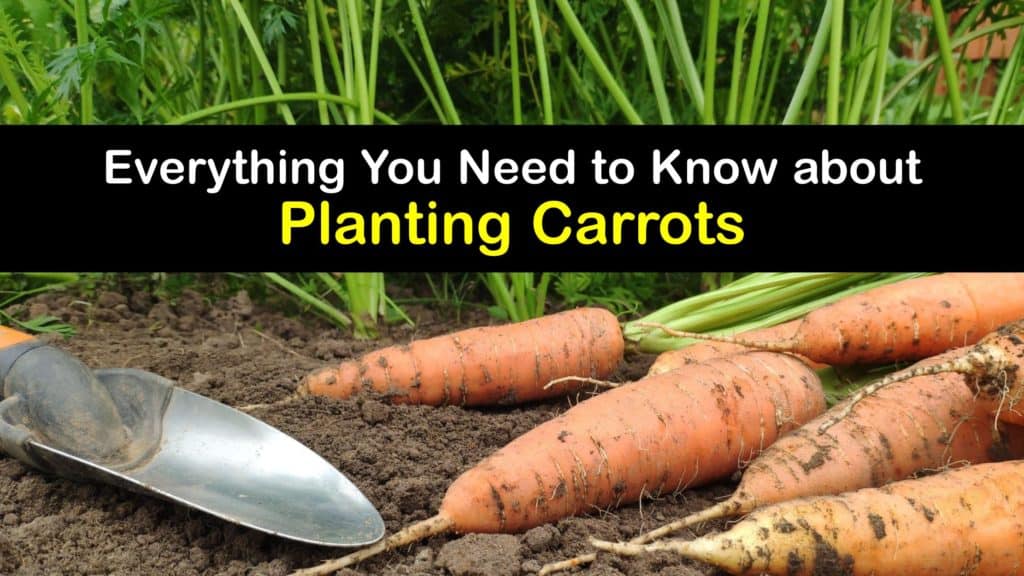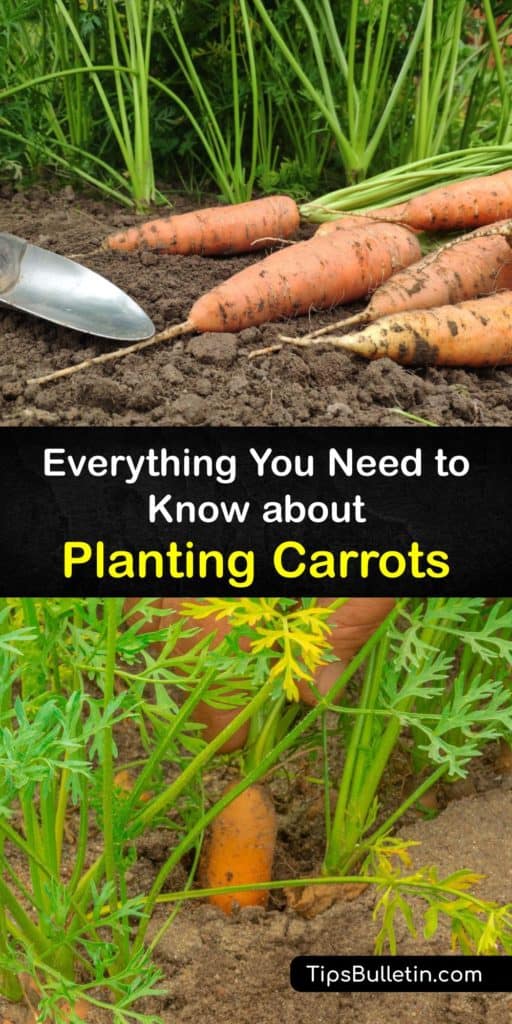Carrots are recognized for their long, orange roots, though they come in various hues and shapes. They are biennial vegetables harvested in their first year of growth before overwintering and blooming the following year. Many gardeners have questions about how to plant carrots, such as how far apart to plant carrots?
Carrot foliage has fern-like compound leaves. Carrot flowers are produced in compound umbels and contain five petals and sepals. The majority of carrot roots are around an inch in diameter and range in length from one to more than 12 inches.
If planted in the early spring, carrot seeds undergo germination in ten to 21 days and it usually takes 50-75 days from sowing to harvest. Carrots are eaten raw as a snack or cooked into several soups, stews, and other dishes. Planting carrots is straightforward, appropriate for container and conventional gardening, and produces a good product yield.

All About Planting Carrots
Carrots (Daucus carota) are members of the Apiaceae family, along with celery, parsnips, and parsley. They are also classified as root vegetables and grouped with radishes and parsnips. Low-calorie vegetables, carrots are rich in vitamins and minerals such as vitamin C, calcium, and potassium.
Learning how to plant carrots and critical principles such as how far apart to plant carrots allows growers to add these tasty vegetable favorites to their home garden or try their hand at producing them in a container.
Planting carrots is straightforward and makes a great project for any grower interested in growing their own homegrown fresh produce. Loose soil and constant moisture are the most vital aspects of producing carrots, and when these parameters are met, most gardeners have success growing carrots.
Carrot Varieties to Grow at Home
Whether growing carrots in the garden, a raised bed, or in a container, the first step in purchasing carrot seeds is deciding which carrot cultivars to grow.
When producing homegrown root vegetables, choose your cultivars based on space, growing conditions in your garden, and your preferred flavor and texture.

How to Plant Carrots
The best way to plant carrots involves choosing a bright area receiving full sun for six to eight hours per day or in a spot with a bit of shade in the late afternoon. Because carrots mature slowly, they have tough roots if forced to grow in heavy soil. Loose soil, which drains well, is optimal for growing carrots.
Carrots thrive in cooler climates. It’s time to plant carrots in zone 6 and most other zones two to three weeks before the final frost. Start planting carrot seedlings or spreading carrot seeds as soon as you can work the soil in the spring.
Planting carrot seeds in succession every few weeks through the spring prolongs the supply. Plant carrot tops easier in the fall and through the winter in warmer climates without fall frost. A row cover provides additional protection from temperature extremes.
How Far Apart to Plant Carrots
Carrot plant spacing is crucial for a good crop, yet it’s not always straightforward and necessitates a lot of thinning of carrot tops. Plant carrot seeds 1/4 inch below the soil surface, two to three inches apart, as evenly as possible.
If some seedlings sprout 1/2 inch apart, that’s fine, though they’ll demand roughly three inches of space as they expand. The most uncomplicated technique to prevent damaging surrounding roots is to snip or pinch the seedlings at the soil line.
Carrots do not require support, and they do not appreciate being transplanted or disturbed.
Growing Carrots in Containers
Carrots demand loose and well-drained soil. They fork and distort if they contact even the tiniest resistance, such as a rock or hard ground in the garden. If your vegetable garden lacks loose soil, consider planting carrots in a container using potting soil explicitly made for potted vegetables.
Carrots with roots typically developing and maturing to two to three inches long, such as Paris Market, are great for containers.
You can easily start carrots indoors or use a pot outside. Make sure your carrot container is 12 to 24 inches wide and 12 inches deep. Growing carrots in buckets requires plenty of drainage holes and a pot made from any material works. Carrots grown in containers demand more water than those grown in the ground, so be sure to water the container thoroughly once a week.
Caring for Carrot Plants
A vital part of learning how to grow carrots is understanding their care. Despite the roots being underground, the foliage does best in full sun to partial shade for the carrot roots to grow quickly and create sugars.
Carrots require loose soil and split and distort if they contact rocks or clumps. Carrots prefer somewhat acidic soil, ranging from 6.0 to 6.8 pH. Give your carrot plants at least an inch of water every week throughout the growing season. Mulching helps preserve water to keep the soil moist and cool. Use bark mulch, straw, or pelleted plastic mulch.
If your potting soil is deficient in organic matter, your plants will need supplemental feeding about two weeks after the tops appear. Any organic vegetable fertilizer of sufficient quality will suffice. You can also use Epsom salt for carrots as a homemade fertilizer. Because they are grown for their roots, avoid using nitrogen fertilizer, which is used primarily to promote foliage growth.
Carrot Plant Pests to Avoid
Carrot rust flies are the most common insect damaging carrots. They lay eggs near the carrot top in the soil. When the fly eggs hatch, the larvae dig their way into the earth and then into the roots of the carrot, where they feed and construct tunnels.
Carrot weevils accomplish the same thing. Some pests can be avoided by rotating your planting locations each year, and the simplest solution is to grow your carrots under a row cover.
Later in the season, nematodes, leafhoppers, or microscopic worms might become a problem, causing damaged roots. Solarization kills nematodes by heating the soil. If you’re having trouble with carrot nematodes in one spot, switch to a different crop and grow carrots elsewhere.
Carrots are susceptible to several leaf spot and bacterial diseases, including Alternaria leaf blight and bacterial soft rot. Keep a careful eye on your carrot plants and remove any showing signs of illness. Because microorganisms survive in the soil, clean up any debris at the end of the season and avoid planting carrots in this garden section next year.
Harvesting Carrots
Carrots or any root vegetable are sometimes tough to grow because you can’t tell how well they’re doing until they’re harvested. When to harvest carrots depends on the kind you’re growing; it usually takes 50 to 75 days from seed to harvest.
To determine when it is time to pull carrots, use the days to harvest listed on your seed packet as a guide. Feel below the soil level to see if the tops of your carrots have reached the expected diameter. Lifting one of the carrots out and tasting it is the only actual test.
If you think you’ll get tender baby carrots if you harvest too soon, you’ll be disappointed. In the supermarket, small carrots are either bred to mature small or huge carrots ground down to a smaller size.
Immature carrots are bland because they haven’t had enough time to acquire their full sweetness. When a crop has been frost-damaged, sweetness often develops.
When it’s time to harvest, twist and pull the carrots from the ground if the soil is exceptionally soft. To be safe, loosen the dirt gently before harvesting the carrots, being careful not to stab them.
Remove the carrot leaves as soon as possible after harvesting as they continue to deplete the roots of energy and moisture, leaving them limp and diminishing the taste of your carrots.
Overwintering Carrot Plants in the Garden
Carrot plants may be left in the garden over the winter. Before the first frost, make sure the space is completely weeded. Apply three inches of straw or dried leaves to the area as a thick mulch. If you reside in a particularly chilly climate, consider installing a cloth row cover.
The carrot tops perish, but the roots continue to collect sugar from withstanding the cold. The roots are delicious if they are left in the ground all winter. If you don’t harvest these carrots before early spring, they’ll start to flower.
The next time you’re looking for radish seeds, consider adding some carrot seeds to your cart. These crunchy root vegetables are amazing baked in butter and sprinkled with chives, added to a hearty soup or stew, or cut up to enjoy raw with some ranch dressing.
Plant carrot seeds with radish seeds, which sprout first and loosen the soil, preventing the ground from hardening and making it harder for carrot seeds to sprout.
Learning how to plant carrots and how far apart to plant carrots gives growers all the tools they need to start planting carrots in their container garden, raised bed, or traditional vegetable patch.

If you loved this article on how to plant carrots, please share these brilliant tips for planting carrots with your friends and family on Pinterest and Facebook.